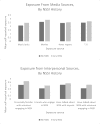Social exposure and emotion dysregulation: Main effects in relation to nonsuicidal self-injury
- PMID: 28800438
- PMCID: PMC5609452
- DOI: 10.1016/j.adolescence.2017.07.015
Social exposure and emotion dysregulation: Main effects in relation to nonsuicidal self-injury
Abstract
We examined the relation of interpersonal and media exposure to nonsuicidal self-injury (NSSI) among 340 university students in the southeastern United States (73.5% female, M age = 19.38 years, SD = 1.15). We also assessed interactions and main effects of each exposure and emotion dysregulation in relation to NSSI, testing the social learning hypothesis of NSSI. Most participants endorsed medium to high levels of exposure to NSSI via media sources. More than one-third of participants were somewhat or very familiar with someone who engaged in NSSI. Almost half reported occasional or frequent conversations about NSSI. Both exposure forms were significantly related to NSSI history. However, hurdle regression analyses revealed that interpersonal exposure and emotion dysregulation, but not media exposure, were significantly associated with NSSI history and frequency. We did not find evidence for an emotion dysregulation-by-interpersonal-exposure interaction. We discuss implications for theoretical models of NSSI, limitations, and future directions.
Keywords: Emotion regulation; NSSI; Self-injurious behavior; Social learning.
Copyright © 2017. Published by Elsevier Ltd.
Figures

Similar articles
-
Restrictive eating and nonsuicidal self-injury in a nonclinical sample: Co-occurrence and associations with emotion dysregulation and interpersonal problems.Compr Psychiatry. 2018 Apr;82:128-132. doi: 10.1016/j.comppsych.2018.02.005. Epub 2018 Feb 11. Compr Psychiatry. 2018. PMID: 29477705 Free PMC article.
-
Stressful Experiences, Emotion Dysregulation, and Nonsuicidal Self-Injury among University Students.J Youth Adolesc. 2019 Jul;48(7):1379-1389. doi: 10.1007/s10964-019-01025-y. Epub 2019 Apr 25. J Youth Adolesc. 2019. PMID: 31025157
-
Extending research on Emotion Regulation Individual Therapy for Adolescents (ERITA) with nonsuicidal self-injury disorder: open pilot trial and mediation analysis of a novel online version.BMC Psychiatry. 2018 Oct 11;18(1):326. doi: 10.1186/s12888-018-1885-6. BMC Psychiatry. 2018. PMID: 30305103 Free PMC article. Clinical Trial.
-
Expanding and clarifying the role of emotion regulation in nonsuicidal self-injury.Can J Psychiatry. 2014 Nov;59(11):569-75. doi: 10.1177/070674371405901102. Can J Psychiatry. 2014. PMID: 25565472 Free PMC article. Review.
-
Emotion dysregulation and non-suicidal self-injury: A systematic review and meta-analysis.Eur Psychiatry. 2019 Jun;59:25-36. doi: 10.1016/j.eurpsy.2019.03.004. Epub 2019 Apr 12. Eur Psychiatry. 2019. PMID: 30986729 Free PMC article.
Cited by
-
"People in my life just play different roles": A retrospective qualitative study of friendships among young adults who self-harmed during adolescence.PLoS One. 2025 Apr 25;20(4):e0320206. doi: 10.1371/journal.pone.0320206. eCollection 2025. PLoS One. 2025. PMID: 40279348 Free PMC article.
-
Perceived vs. Actual Emotion Reactivity and Regulation in Individuals With and Without a History of NSSI.Front Psychol. 2021 Mar 1;12:612792. doi: 10.3389/fpsyg.2021.612792. eCollection 2021. Front Psychol. 2021. PMID: 33732185 Free PMC article.
-
A meta-analysis of the relationship between anxiety and non-suicidal self-injury based on knowledge graphs.Front Psychiatry. 2025 Jan 6;15:1493823. doi: 10.3389/fpsyt.2024.1493823. eCollection 2024. Front Psychiatry. 2025. PMID: 39834578 Free PMC article.
-
Understanding Social Influence of Non-Suicidal Self-Injury: The Interplay of Peer Networks and Adolescent Behavior.J Youth Adolesc. 2025 Aug;54(8):2035-2048. doi: 10.1007/s10964-025-02178-9. Epub 2025 Apr 2. J Youth Adolesc. 2025. PMID: 40175835
-
Individual characteristics of adolescent psychiatric patients accessing psychotherapy in China.Sci Rep. 2022 Oct 9;12(1):16943. doi: 10.1038/s41598-022-21320-2. Sci Rep. 2022. PMID: 36210367 Free PMC article.
References
-
- Akers RL. Deviant behavior: A social learning approach. 2-nd. Belmont, CA: Wadsworth; 1977.
-
- Bandura A. Social learning theory. Oxford, England: Prentice-Hall; 1977.
MeSH terms
Grants and funding
LinkOut - more resources
Full Text Sources
Other Literature Sources
Medical

